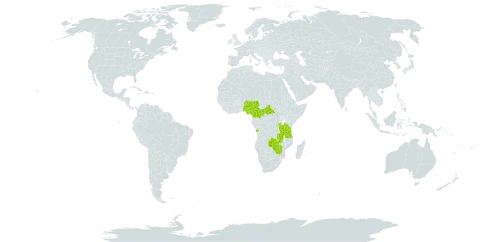An erect herb. The stems are 50 cm high. It grows from a woody rootstock. It has a series of small tubers. They are almost round and 1.5 cm across. The stems have small hairs. The leaves are broadly oval and velvety on both surfaces. The flowers are on long hairy stalks and in the axils of leaves or at the ends of branches. They are dark black-brown outside and creamy pink inside. The fruit are pods 1.2 mm long by 9 mm wide.
Leaves 1-foliolate; leaflet 1.5–10.5 × 1.2–8 cm, ovate-oblong, ovate or nearly round, acute to broadly rounded but apiculate at the apex, cordate, pubescent to velvety on both surfaces, many of the hairs yellow and glandular-based, venation raised beneath, often reddish-brown; petiole 4–16 mm long; petiolule 3–4 mm long; stipules 7–16 × 1.5–6.5 mm, ovate to lanceolate, with long hairs, short hairs and glands, veined.
Standard purple or deep blackish-brown or more rarely yellow outside, cream-coloured or yellow with dark lines inside, (6.5)8–8.5(12) × 5–6(9.5) mm, oblong-obovate, pubescent in the median area, the hairs near the claw stiffer and with yellow glandular bases; wings and keel white, yellow or cream-coloured sometimes tipped with red.
Racemes terminal and axillary, the flowering part 1–4.5 × 1.5 cm; peduncle 1–4 cm with short hairs and long glandular-based hairs; pedicels c. 1 mm long; bracts persistent, 0.5–1.7 cm long, linear.
Erect perennial herb, with 1–several branched or unbranched stems 7–25(50) cm tall, from a woody rootstock or series of small tubers c. 1.5 × 1.2 cm.
Calyx c. 4–8 mm long, covered with short hairs and longer glandular-based hairs; lobes lanceolate, ± equalling the tube.
Pods 10–13 × 7.5–10 mm, obliquely oblong, covered with short hairs, long hairs c. 2.5 mm long and sparse glands.
Stems covered with short hairs and longer yellow hairs mostly with thickened glandular bases.
Seeds black, 5–5.5 × 3–3.5 × 1 mm, oblong; rim aril yellowish-white, widest at end of seed.
Erect undershrub, stem 6 in to 1 ft. high, from a woody rootstock
Flowers purple
